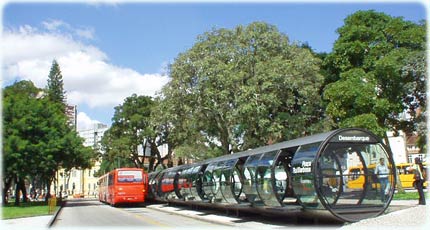
As I just completed some research on sustainable cities, I thought I would include an excerpt here from my paper (minus the diagrams). I won't bore everyone with the theoretical basis of sustainable cities, but you'll get the idea by reading this section about the city of Curitiba, Brazil, which is generally acknowledged to be one of the most sustainable cities in the world. This fact is even more remarkable when one considers that it is quite a poor city, yet has managed to achieve more sustainability than cities in the global North through innovative means. For example, the pic above is of bus 'boarding tubes'. When you're waiting for the bus (which isn't a long wait), you enter your token to get into this tube. This saves precious time, as when the bus gets there, everyone is ready to just get on without fare-paying delays. Enjoy!
Case Study: Curitiba, Brazil
At this point, it will be very useful to examine the sustainable city initiatives of a particular city in order to further illustrate the previous theoretical points. Rabinovitch (1992) notes several historical facts about the development of Curitiba’s sustainable policies and structure. The city of Curitiba is located in South Brazil, and has been both a political and administrative centre for a many years. During the 1960’s, planners made a conscious decision to prioritize public transit over the car, focus on hundreds of small projects (while avoiding large expensive ones) and discourage new developments downtown. The goal was to encourage urban expansion along the transit lines (which extend outward from the downtown), which would leave the downtown area’s history preserved, and allow more public space for citizens. Thus, a more transit and pedestrian friendly city was created.
There are several specific features of Curitiba which deserve further examination (see Figure 3 for a complete list).
First, the city’s heritage has been preserved in its architecture. Local government allowed businesses to utilize historic buildings with the condition that the building was not substantially physically changed. Thus, a theatre now sits in a building which was once a gunpowder arsenal.
Second, lest the reader think that a sustainable city cannot have industry, it should be noted that the city also has an industrial area, which is not isolated but contains housing, schools, green space, etc. Industries must adhere to strict environmental regulations. (Rabinovitch, 1992).
Third, Curitiba provides many services (delivered in an inexpensive, innovative and sustainable fashion) to their citizens. Rabinovitch (1992) notes that their water sanitation system, which uses a system of local lagoons for filtration, is cheap, effective and uses the local ecosystem. Many environmental education programs have been implemented in poor areas, and old city buses are used as mobile learning centres to teach adults useful trades. Basiago (1999) describes a program in which the poor can exchange six bags of garbage for healthy groceries, thus combating urban starvation and keeping the city clean. With recycling, and equally innovative approach was taken: the local government asked citizens to separate wet from dry garbage. The government then set up plays at local schools featuring the “Leaf Family” to show kids how to recycle. Thus, kids consider recycling fun, and encourage their families to participate. The author also observes that the local government ensures that the basic needs of the poor are met by providing free dental and health care. Further, free child care is provided to allow parents to work, which has resulted in a significant decline in infant mortality rates.
Fourth, the many green areas not only provide aesthetic value, but also act to control flooding. (Rabinovitch, 1992). Curitiba has taken many measures to encourage green space such as creating ‘green zones’, building a botanical park downtown, and passing laws to discourage cutting down trees while mandating that two trees must be planted for each one cut down. (Basiago, 1999).
Fifth, strong local governance and active citizen participation are encouraged. The mayor of Curitiba has noted that “….we take the administration to the community and promote administrative decentralization, cutting red tape and serving the people” (Alberti & Dos Santos, 1996, p. 438)
Finally, the pride and joy of Curitiba is their transit system. The choice to use only buses proved to be exceedingly practical and economical for Curitiba (see Figure 4). Not only have they implemented a bus system with many desirable features, but it is well integrated into land use planning and zoning. For example, only high rises are allowed to be built along major bus routes, and the bottom two floors of these must contain stores. Thus, residents need to travel less for shopping, many residents have easy access to transit and it provides local employment. The express buses travel in bus-only lanes, and are supplemented by local and downtown routes. In addition, passengers pay their fare while waiting for the bus, which makes the boarding process faster and more efficient (Basiago, 1999). Rabinovitch (1992) adds that one fare is valid for all types of buses, making travel much more convenient. Consequently, two-thirds of the population uses transit and this popularity allows it to pay for itself (Basiago, 1999). Thus, “Curitiba’s public transportation system is directly responsible for the city having one of the lowest rates of ambient air pollution in Brazil….residents spend only about 10% of their income on transport, which is a relatively low proportion for Brazil”. (Rabinovitch, 1992, p. 66).
References:
Alberti, M & Ricardo Dos Santos, C. (1996). Interview with the Mayor of Curitiba on Habitat II. Environmental Impact Assessment Review, 16, pp. 435-438.
Basiago, A.D. (1999). Economic, Social and Environmental Sustainability in Development Theory and Urban Planning Practice. The Environmentalist, 19, pp. 145-161.
Rabinovitch, J. (1992). Curitiba: Towards Sustainable Urban Development. Environment and Urbanization 4(2), pp. 62-73.

No comments:
Post a Comment